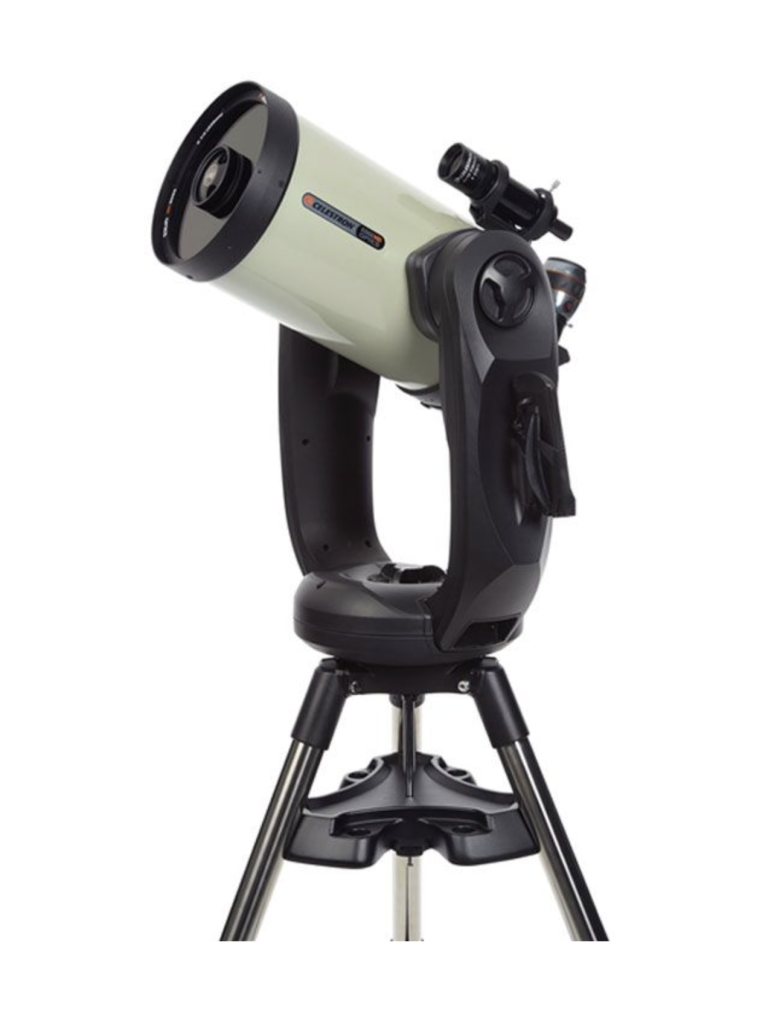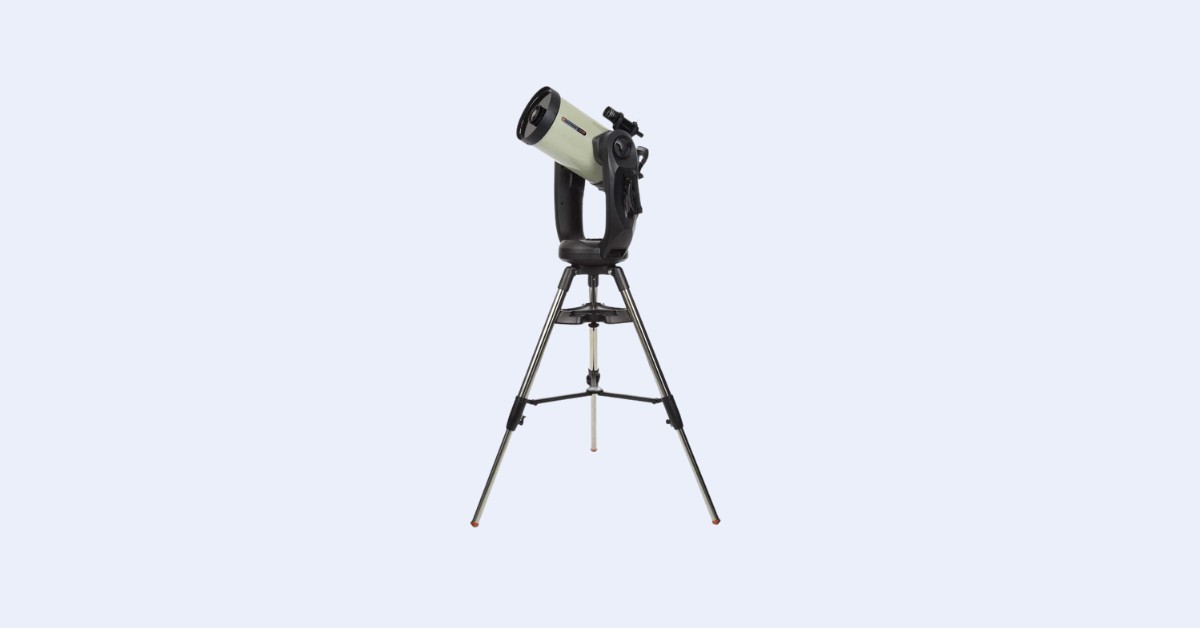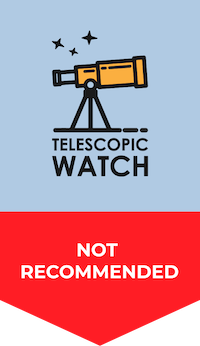The C9.25 EdgeHD Optical Tube
The Celestron CPC 925 EdgeHD is a type of aplanatic Schmidt-Cassegrain telescope that uses the EdgeHD optical configuration with an aspheric secondary mirror and internal corrector lenses to provide better edge-of-field sharpness than regular Schmidt-Cassegrain telescopes, mainly for astrophotography purposes. Its 9.25″ (235mm) primary mirror and 2350mm focal length, with an f/10 focal ratio, are a middle ground between the C8 and larger 10” or 11” Schmidt-Cassegrain telescopes. The C9.25 (both XLT and EdgeHD) optical design features a slightly slower primary mirror than most SCTs (f/2.3 vs the standard f/2) and a resultingly less curved secondary mirror, making it less sensitive to misalignment and easier to manufacture to high tolerance than other SCT designs. As a result, both the C9.25 XLT and EdgeHD tend to perform slightly better than one would expect and are more consistent in quality between units.
The Celestron EdgeHD design is akin to Meade’s ACF system, but with better performance and added versatility such the ability to be converted to an f/2 Schmidt camera using Starizona’s HyperStar system, a better dedicated f/7 reducer available, and features like a set of 3 mirror locks and HEPA-grade filtered vents to accelerate cooldown. However, the CPC mount is not exactly a astrophotography-ready mount from the outset and the EdgeHD’s benefits for visual work and planetary imaging are minimal compared to the regular C9.25 XLT optical tube.
Like all Schmidt-Cassegrain telescopes, the focus system of the CPC 925 EdgeHD moves the primary mirror along a rail inside the telescope, and it is adjusted with a knob at the back. The EdgeHD design boasts mirror locks that can be utilized during long exposures for astrophotography to prevent “mirror flop,” but this feature is not necessary for most planetary imaging or visual use. Standard Schmidt-Cassegrain threads at the back of the optical tube enable the attachment of the provided 2” screw-on diagonal, focal reducers, or a T-adapter for a camera. Furthermore, the CPC 925 EdgeHD optical tube is outfitted with holes for attaching dovetail bars for mounting to a different mount than the CPC or for adding accessories like a guide scope or power boxes. You collimate the scope with a set of three screws at the front to tilt the secondary mirror as with any other Schmidt-Cassegrain; more info can be found in our collimation guide as to how this process is done.

Accessories
The CPC 925 EdgeHD telescope package comes with a 2” screw-on dielectric mirror star diagonal that has a 1.25” adapter. This high-quality diagonal is suitable for visual use and produces excellent results. The scope also includes a 23mm Luminos eyepiece, which offers an 82-degree apparent field of view similar to UWA, Nagler, and ES82 eyepieces. Although slightly less effective in faster telescopes, this is not an issue for the EdgeHD 9.25 at f/10. When used with the EdgeHD 9.25, the 23mm Luminos provides a magnification of 102x and a true field of 0.8 degrees, which is equivalent to slightly over one and a half times the apparent diameter of the full Moon in the sky.
The CPC 925 EdgeHD also comes with a straight-through 9×50 finder that attaches to a non-standardized bracket on the optical tube. The finder features crosshairs for precise pointing and provides an approximately 6° field of view, enabling users to observe stars and bright deep-sky objects up to several magnitudes fainter than what’s visible to the naked eye. While this may seem excessive for aligning a GoTo telescope, it’s still a useful and appreciated feature.
The CPC Fork Mount
The GoTo alt-azimuth fork mount of the CPC 925 EdgeHD has adjustable clutches for manual aiming when the scope is not powered on, along with an automatic internal clock and GPS system that updates location, date, and time. The 9.25″ EdgeHD optical tube can technically be removed to attach a dovetail bar to be used on an equatorial mount. However, “de-forking” the optical tube is a time-consuming process and cannot be easily reversed, which means that for the most part the scope can be treated as though it were permanently attached.
Assembling the CPC is a straightforward and simple process of extending and leveling the tripod, attaching the spreader tray, and placing the scope on top. There is not a lot of assembly required compared to an equatorial mount – however, the EdgeHD 9.25 tube and CPC forks together weigh about 58 lbs, and have to be centered precisely on a small center pin when you lower them onto the tripod. This can be rather uncomfortable and may be hard on your back; an equatorial mount allows for breakdown into smaller and more easily managed pieces. The weight and bulk of the CPC is the trade-off for fewer assembly steps.
The CPC fork mount’s NexStar+ hand controller automatically obtains date, time, and location from the built-in GPS sensor and will prompt you with a relatively simple alignment process of centering 2 or more bright stars, after which the telescope can point to and track any of the 40,000 objects in its database. Additional Celestron accessories, such as the StarSense AutoAlign system or SkyPortal WiFi adapter, can also be added to the mount to further simplify the setup and use.
While the CPC 925 EdgeHD can be converted to an equatorial configuration for deep-sky astrophotography with an equatorial wedge, it is not as capable as a dedicated equatorial mount and placing the scope atop the wedge is even more difficult than regular assembly. Accurate polar alignment is also rather difficult to achieve compared to a German equatorial mount. However, the mount does have features such as all-metal worm gearing and an autoguider port that do enable it to be used for acceptable-quality deep-sky imaging if you do choose to go with this configuration.
Should I buy a Used Celestron CPC 925 EdgeHD?
It is important to ensure that any used GoTo telescope powers up, slews, and tracks, and that the optics are in good condition before purchasing a used unit. A failed GPS unit in the CPC fork mount can be ignored, while a missing hand controller or accessories can of course be replaced for fairly little cost.
The real concern is the possibility of damage to the CPC 925’s EdgeHD optics or the presence of significant dirt or debris inside the telescope. Unlike a standard Schmidt-Cassegrain, attempting to dismantle EdgeHD optics and clean them oneself is not advisable, and sending the telescope back to Celestron for repairs can be expensive, often costing more than buying a new unit. If the 9.25” EdgeHD optical tube’s corrector plate or internal lenses are damaged, replacing the entire optical set is typically not cost-effective and could take months to complete by sending the scope to Celestron.
Alternative Recommendations
For those interested in deep-sky astrophotography, it is generally recommended that you consider a telescope mounted on a German equatorial mount in a modular configuration rather than a fork-mounted Schmidt-Cassegrain like the CPC 925 EdgeHD. While some astrophotography telescopes come with equatorial mounts, it is often better to purchase the mount separately. Most of the best astrophotography telescopes are sold without mounts, so it’s important to do your research before making a purchase. Check out our Mount Rankings page for more information on finding the right mount. In addition to the Celestron EdgeHD line of optical tubes, there are various apochromatic refractors and imaging Newtonians available for deep-sky astrophotography, with many beginners choosing refractors due to their simplicity. Our OTA Rankings page provides more information on selecting the right optical tube assembly for your astrophotography needs.
Most of the time categorize our alternative recommendations by price range, but with such a wide selection at the CPC 925 EdgeHD’s price range, here’s a short list of some of the scopes you might want to consider instead for visual observation and planetary imaging use.
- The Celestron Advanced VX 9.25” Schmidt-Cassegrain offers the same views and GoTo functionality as the CPC 925 EdgeHD, but breaks down into more easily managed pieces. The Advanced VX mount is also fairly capable for deep-sky astrophotography with a smaller telescope optical tube and suitable addons.
- The Celestron CGEM II 1100 and CPC 1100 offer greater aperture than the CPC 925 EdgeHD, though either is quite heavy, bulky and limited in field of view while the CPC 1100 exacerbates the issue of the overly heavy combined tube/fork mount and the difficulty of placing it atop a tripod.
- Sky-Watcher offers Flextube GoTo Collapsible Dobsonians in 8″, 10″, 12″, 14″, and 16″ apertures, with the smaller three also available in more affordable manual-only formats. These telescopes feature compact designs and GoTo functionality with Sky-Watcher FreedomFind encoders, which allow for manual aiming without affecting GoTo accuracy or tracking. The FlexTube design increases portability compared to a solid-tubed Dobsonain somewhat while maintaining ease of setup compared to a full truss.
- The Apertura AD/Zhumell Z/Orion SkyLine Dobsonians come in 8″, 10″, and 12″ apertures, offering great value for money and delivering excellent views at the eyepiece. They come with sturdy mounts, useful accessories, and features all at a rock-bottom price.
- Explore Scientific’s Truss Tube Dobsonians come in all-metal designs with buttery-smooth mounts and compact, dismantled forms. Available in hybrid and deluxe 10″, 12″, and 16″ apertures, they provide excellent optical performance. However, these telescopes include few useful accessories and can be more complex to assemble in the field due to their truss tube designs.
- Celestron’s StarSense Explorer Dobsonians are available in 8″ and 10″ apertures and come with an optimized, lightweight mount design and Celestron’s StarSense Explorer technology that helps users navigate the night sky using their smartphones. However, they do not come with many accessories or additional features despite the higher price tag than most other Dobsonians.
Aftermarket Accessory Recommendations
If you own a CPC 925 EdgeHD or any other catadioptric telescope, it is highly recommended that you invest in a dew shield to prevent moisture build-up on the front corrector plate during damp nights. This not only affects the image quality but also can cause damage to the coatings. A basic plastic or homemade dew shield may suffice, but there are also heated options available for those in extremely humid environments. In addition to its moisture-blocking benefits, using a dew shield can help reduce stray light and improve contrast at the eyepiece, especially in light-polluted areas or during bright moon phases.
For visual observation with the EdgeHD 9.25, there are numerous eyepieces and accessories to choose from. The included 2″ star diagonal opens up many possibilities, and the Apertura 38mm SWA eyepiece offers a wider field of view and larger exit pupil than the provided 23mm Luminos for low-power observations of deep-sky objects. For medium to high magnifications, wide-angle eyepieces like the Baader Hyperions or Explore Scientific 82-degree line are recommended. It is advisable to have at least three or four high-quality eyepieces to take full advantage of the telescope’s capabilities, though cheap “goldline” or “redline” eyepieces work just fine at f/10 too. We would also recommend a UHC filter like the Orion UltraBlock to improve your views of nebulae such as the Orion Nebula; the contrast increase these filters provide is particularly helpful from light-polluted locations. Lastly, you’ll need a power supply such as the Celestron PowerTank Lithium Pro to run the CPC fork mount for lengthy observing sessions.
What can you see?
The CPC 925 EdgeHD delivers exceptional deep-sky views, as one would expect from a telescope of this caliber and aperture size. Open star clusters such as M35 and M11 look spectacular. However, larger clusters like the Pleiades (M45) and Beehive (M45) are too vast to fit in the EdgeHD 9.25’s limited field of view of no more than 1.1 degrees, which can be disappointing. Globular star clusters such as M15 and M13 reveal individual stars, differences in brightness, size, and shape when viewed at high power, although some may still be out of reach. There are also plenty of colorful double stars you can split with this telescope on a steady night.
Observing galaxies requires dark skies; they appear as faint washed-out smudges in urban areas with little detail to be seen in any telescope. Nevertheless, the CPC 925 EdgeHD is capable of revealing dust lanes and even spiral arms in several galaxies under optimal conditions, as well as groups of galaxies such as the Leo Triplet and the Virgo Cluster. Emission nebulae such as Orion (M42), the Swan (M17), and the Lagoon (M8) are still visible even under light-polluted skies. They become stunningly detailed under darker skies and with the help of a UHC nebula filter. Moreover, planetary nebulae present a wealth of colors and intricate details when viewed at high power under steady skies with the CPC 925 EdgeHD.
The CPC 925 EdgeHD is just as good as the regular CPC/C9.25 XLT for planetary observation. The telescope provides sharp views of the phases of Venus and Mercury, while the Moon reveals an incredible amount of detail, such as its craters, mountain ranges, ridges, and smooth basaltic maria. During the few months around opposition when Mars is closest to Earth and at its biggest and brightest, the planet’s polar ice caps and a few dark surface markings are visible. Jupiter’s vivid cloud belts, storms, and the Great Red Spot are clearly visible, as well as the disks of all four Galilean moons, along with their shadows, during their transits in front of Jupiter. The rings of Saturn are magnificent, with the razor-thin Cassini Division within and a handful of moons scattered around the planet. On an especially steady night, the CPC 925 EdgeHD can even bring out the Encke gap in the rings. Uranus’ turquoise disk and a couple of moons can be spotted, while Neptune is just barely visible, along with its accompanying moon Triton. Finally, Pluto is just within reach of the CPC 925 EdgeHD’s light-collecting power under dark skies, though it can be challenging to locate.
Astrophotography Capabilities
The CPC 925 EdgeHD is capable of being used for long-exposure deep-sky astrophotography with the use of an aftermarket equatorial wedge and either a Hyperstar f/2 kit or f/7 reducer, but accurately polar aligning this configuration can be extremely challenging, and its tracking and guiding quality falls short of what a quality German equatorial mount like the Sky-Watcher EQ6Ri Pro or Celestron CGX can offer when paired with the EdgeHD 9.25″ optical tube.
For lunar and planetary imaging, the CPC 925 EdgeHD performs well, just like any other good Schmidt-Cassegrain telescope of this size equipped with tracking. Using a suitable CMOS high-speed planetary camera such as the ZWO ASI224MC, and adding a 2x or 3x Barlow lens to boost the scope to f/20-f/30, can produce stunning results with free image capture and processing software and just a few minutes of footage. However, as noted previously, the EdgeHD optics do not provide a significant or even noticeable advantage over the standard C9.25 XLT/CPC 925 for this task.



